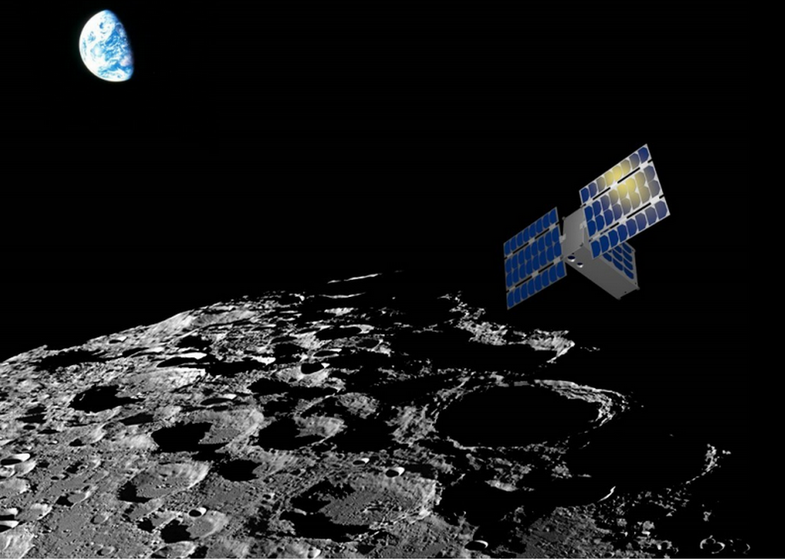CubeSats Are Paving Mankind’s Way Back To The Moon, And Beyond
Tiny satellites could help turn the Moon into a gas station for solar system exploration

It’s been over 40 years since humans last set foot on the lunar surface. But that doesn’t mean we’re done exploring the Moon. In fact, there have been over 50 successful robotic missions to the Moon, including six current missions operated by three different space agencies.
So we’ve been the Moon. Now what? Many say we shouldn’t go back–instead let’s go to Mars. But, what if the only feasible way to get humankind to Mars is by way of the Moon?
That’s what the Lunar Polar Hydrogen Mapper, or “Luna-H Map”, is trying to figure out. The SpaceTrex lab at Arizona State University has partnered with NASA to create a tiny satellite with one important goal: to measure and locate the exact amount of water on the Moon.
Why do we care about water on the moon? Because water can be split into hydrogen and oxygen, and when you mix those two ingredients back together, you get combustion. Or in other words, the Moon’s water could be made into rocket fuel.
Jekan Thanga, the head engineer on LunaH-Map dreams of a lunar gas station for astronauts. “Just think, we could have a refueling station at the L2 point,” he says, referring to a point beyond the Moon where gravitation alignments would allow supplies in space to remain stationary. “Our astronauts could stop there to refuel and stock up on supplies before heading out to Mars, or Europa.”
The Moon’s water could be made into rocket fuel.
There seems to be a decent amount of H2O on the Moon, but scientists aren’t sure exactly how much is there, or where it’s concentrated. Craig Hardgrove, the principle investigator for LunaH-Map says, “We’re trying to prove that there’s water at the lunar poles.”
NASA has been hoping to answer these questions for years, but it hasn’t had the funding or the support to send people or landers back to the Moon. That’s where CubeSat technology comes in. CubeSats are very small satellites, about the size of an oversized Rubik’s Cube. Advanced scientific instruments can be packed inside these tiny spacecraft to obtain information the same way a larger craft would, but for 1 percent of the price. The 4-inch cubes can also be stacked together to add more room for instruments. (LunaH-Map is about the size of a cereal box.)
Because of their small size, CubeSats can hitch rides on rockets with larger payloads and get released on their own trajectories to conduct their own science, opening up possibilities to explore the solar system in missions that otherwise wouldn’t have been funded.

CubeSats measure about four inches on each side
Many scientists compete for these coveted spots on mission payloads. To date there is one particular space ride that CubeSat scientists are vying for, and it happens to be on the most powerful rocket ever built. The first official launch of NASA’s Space Launch System and Orion spacecraft will take place in 2018, and onboard it will carry 11 separate CubeSat missions into deep space (including BioSentinel, which will measure the effects of space radiation on yeast DNA). It will also be swinging around the Moon and dropping off LunaH-Map along with potentially two other lunar CubeSats, to answer the water question once and for all.
But CubeSats won’t stop at the Moon. Next year, two will travel to Mars with NASA’s Insight Lander, becoming the first CubeSats to leave Earth’s orbit.
The Mars Cube One, or MarCO, CubeSats have a temporary but critical objective: they will serve as real time communications liaisons between the InSight lander and the scientists at Jet Propulsion Laboratory. This task of relaying real-time information has traditionally been the job of the Mars orbiter Odyssey. However, the alignment of Odyssey doesn’t sync up with InSight’s landing coordinates. Instead, MarCo A and B will relay data during the lander’s descent and landing. After that, the Mars Reconnaissance Orbiter will take over communications with Earth, and the CubeSats’ mission will be complete.

Lunar Flashlight is another CubeSat mission that will look for water on the moon
MarCo A and B will be the first CubeSats to participate in an interplanetary mission, but they definitely won’t be the last. There’s talk of building a CubeSat to accompany NASA’s future mission to Jupiter’s moon Europa.
Europa contains an ocean with more water than Earth, so the mission to Europa carries with it high hopes for finding life. With a minimum six-year journey to Jupiter’s moon, mission scientists have one shot at obtaining data during the flyby. Adding a CubeSat has the potential to increase the amount and the kind of data scientists could get from the mission.
Since 2000, more than 300 CubeSat missions have been tested and deployed in Earth orbit, including the Planetary Society’s LightSail this year. Bill Nye, CEO of the Planetary Society, has said of CubeSat technology: “When you go exploring, two things happen. First, you make discoveries. The other thing is you’ll have an adventure, and I think we all want to be a part of space exploration.”
As scientists and engineers continue to develop more efficient technology, CubeSats and small science instruments like these will continue to open the doors to universities and organizations wanting to participate in space exploration. As long as there’s more science to do and mysteries to uncover, it’s safe to say the era of CubeSats will continue to advance, and maybe even help humans get deeper into space.